My first flight
on the current version of the Wills Wing Fusion was trial by
fire. I had arranged for a glider to try during the King Mountain
meet in Idaho. The problem was timing. During the previous two
weeks I was running a World Hang Gilding Series meet in Greece.
So I jumped on a plane on Friday at 7:30 am in Athens, and 23
hours later arrived at King Mountain. I snatched 40 winks and
awoke the morning of the first competition day. To my surprise,
my borrowed glider was lying on the ground next to my van. Not
only was this Fusion brand new but it came with a cross-country
bag and a hat to boot. I started out that day with a smile thanks
to Wills Wing's extra effort.
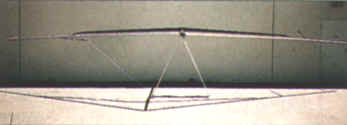
|
Figure
1: The naked Fusion airframe shows the sprogs just beyond
the crossbar junction (one adjusted up, one down). Note
also the downward curve at the outboard crossbar end.
|
But the smile soon faded when we went up the hill to find
winds of over 30 mph. How would the glider handle in turbulence!
Would I feel secure with its stability! What about its performance!
Most of my doubts were answered soon after launch, as I climbed
out effortlessly. Turbulence was mild and I easily penetrated
the higher winds aloft to get my start photo. I eventually
made goal on this strong crosswind day and walked around the
glider with a smile on my face. I stroked the membrane, ogled
the clean, curvaceous upper surface, kicked the tires and
mused: "I believe Wills Wing has made the perfect glider"
Perfection is hard to come by in my cosmos, so after the first
flush of infatuation abated I looked more critically for flaws.
I did find a minor point or two which we shall report in due
time, but it is clear to me that Wills Wing has fused all
the good ideas from their previous gliders with a few new
items to achieve a design that approaches perfection.
For your edification we present the WW Fusion.
|
Figure
2: A head-on view of the full-dress Fusion. Notice the
winglets and the outboard area held twisted by the sprogs.
|
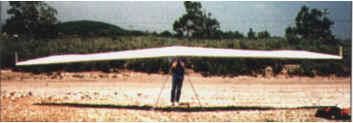
|
TOPLESS TOPICS
No doubt every pilot with a pulse has become aware of the
topless glider revolution. The promise is improved performance,
but this improvement comes at a price. This price must be
paid not just in dollars, but also in weight and possibly
stability. We shall see how Wills Wing handled these potential
problems.
Before we begin, let me list my personal glider desirables
in order of importance. These are: safety, top performance,
handling, ease of takeoff and landing, light weight, ease
of setup, appearance and price.
|
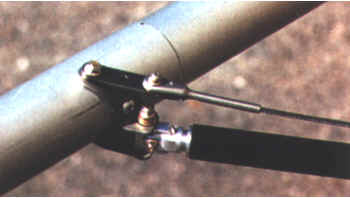
|
Figure 3:
The sprog forward attachment with its cable and universal
joint.
|
Safety is most important to me because I fly for fun, and
it is not fun to be continually in doubt about a glider's
integrity. Controllability, strength and stability are the
main safety factors, and these are all tested to a certain
degree during the HGMA certification process. The Fusion has
passed its HGMA tests handily, but the proof is in the flying.
During the 13+ hours I flew the Fusion at King Mountain I
never felt insecure when it came to the glider's structural
integrity, controllability or stability -- this, despite a
consensus that many of us encountered some of the strongest
winds and turbulence in our competition experience. In my
opinion the Fusion feels as solid and dependable as any kingpost
equipped glider.
Let us look a bit further at the pitch stability question.
Without a kingpost a glider cannot have reflex bridles (lufflines).
These pitch stability devices are most useful when a negative
angle of attack is encountered in a gust or incipient pitchover.
Without reflex bridles some other method is required to slow
or stop a glider's negative pitching motion. Enter sprogs.
|
Figure
4: A view of the sprog aft end with its hookup ring.
|
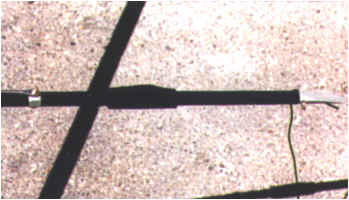
|
A sprog is simply a glorified washout strut that limits how
much the rear of the sail can blow down at the sprog location.
Ideally, a sprog should be placed as far toward the glider's
wing tip as possible to hold twist in the sail well behind
the glider's CG point. However, leading-edge rigidity and
strength come into play, so the Fusion's sprogs ended up about
70% out on the leading edge (see photos). The addition of
a transverse batten parallel to the trailing edge to spread
the sprog's influence, as well as conventional washout struts
at the tips, complete the minimum twist-limiting package.
To assure you that such a system works, note that many rigid
wings such as the Fledgling and later the Swift derive their
pitch stability by similarly establishing minimum wing twist,
and their pitchover record is admirable.
The Fusion's sprogs are held by a bracket fastened to the
leading edge and a cable which limits how far downward the
sprog can swing (see photo). The angle of the sprog can be
adjusted by unfastening the cable and twisting the sprog tube.
The owner's manual clearly outlines this procedure, and proper
adjustment must be maintained for safety and ease of control.
Incidentally, the term sprog was recently coined at the Pre-World
meet in Australia. The term comes directly from a Gottawanna
Aborigine dialect and means "aggressive little swimmer."
|
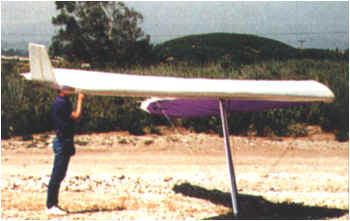
|
Figure 5:
Side view of the Fusion demonstrates the far-forward
batten profile. Mike Meier holds the keel.
|
Other pitch stability systems on the Fusion include the upper-to-lower
sail connections, the reflexed root section and the airfoil
shape. Notably, the airfoil is thickly cambered with a well-forward
high point which leads to good climbing ability and good pitch
stability respectively (see sideview photo).
We have spent a good bit of space discussing pitch stability
because in many pilots' minds this is the big question regarding
topless gliders. In my estimation a properly-set-up and maintained
Fusion is as stable in pitch as conventional kingposted high-performance
gliders.
FUSION PERFORMANCE
Now we proceed to more fun stuff. It should be no surprise
to most that the Fusion will out-glide conventional gliders,
as do most topless gliders. But how does the Fusion climb
and how does it stack up against the other topless competitors!
We have already mentioned that the glider has a climbing airfoil.
In fact, rumor has it that the Fusion was constantly compared
with the best-climbing glider available during development,
and it wasn't released until it matched up. I can report that
in my own ham-handed experience I never felt outclassed in
climb with my Fusion. More tellingly, many other pilots in
hundreds of comparison competition climbs reported a similar
experience. The Fusion's climb rate stature is reminiscent
of the Wills Wing HP AT which was a hard one to beat in its
day.
The other pure performance factors of most interest are best
glide and glide at speed. I can report that near best glide
speed the Fusion matches any other topless glider you care
to pull off the truck. At high speeds I have less definite
information, because the only time I used these speeds was
when diving into goal, and then I was always alone. I suspect
that the fat, forward airfoil hurts the Fusion a bit in this
category, but that doesn't concern me since we rarely use
speeds produced by pulling the bar to our waist or further.
Besides, body position and harness type are as important as
anything in this flight regime.
Conclusion: The Fusion is equal to everything out there in
the weight-shift world, and pilots with top-rigged gliders
will enjoy an increment of performance if they trade up.
HANDLING THE FUSION
I mentioned that my first climb out on the Fusion was effortless,
as were succeeding climb outs on subsequent days. But what
I didn't disclose is that after I left the mountain on course
the VG system was stuck full-on, yet I was still able to stick
the glider in a thermal and go up. And, of course, I still
admired that wing when the flight was over.
To understand why it got stuck, we must understand the VG
system. The Fusion's VG works with levers out at the end of
the crossbars that push the leading edges forward by effectively
lengthening the crossbar (see photo). This system is very
efficient in that it provides a tremendous mechanical advantage.
Thus, the VG rope offers very light resistance and the total
pull length is not excessive. The VG effect on the Fusion
is equivalent to moving the crossbar twice as far as on a
Wills Wing XC.
Combine the above-mentioned effective VG with the optional
rang on the rear pullback and a pilot can truly dial in whatever
handling/performance tradeoff is desired. In the loose VG
setting the Fusion's handling can best be described as sweet.
Turn initiation was easy and responsive while coordination
was, well, coordinated. No tricks, no surprises, no sweat.
Full-tight the glider was essentially the fixed wing it seems
to emulate. I had the sissy ring on my glider so perhaps that's
why I could turn the thing with full VG. Without this tang
the glider flies straight and flat.
|
Figure
6: The Fusion's VG lever located at the end of the crossbar.
Note the stepped-down leading edge.
|
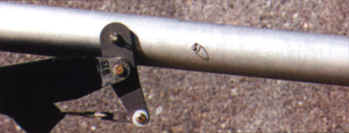
|
I could detect no tendency to wing walk or Dutch roll. However,
I aerotowed an earlier version in strong turbulence and did
oscillate a bit at first until I worked out the coupling.
I expect the Fusion to be moderately resistant to yaw/roll
oscillations.
Incidentally, the reason my VC was stuck on is that the VG
line got stuck in the keel pocket that wraps in front of the
control bar. After that first flight I made sure to keep the
VG line under a little tension so it didn't sag and get captured
between the pocket and keel on launch. From that point on
the VG worked magically.
My first criticism of the Fusion concerns the VG jam cleat
that is placed on the corner of the control bar. It is an
ingeniously simple and effective device, but I dislike having
to reach so far for the line. I would prefer it to be nearer
my hand on the basetube so I could put it on and off in a
thermal without looking and letting go for too long. This
is an important matter when entering a glider-infested thermal.
Conclusion: The Fusion's handling is quite light with a solid
feel during turn coordination. The terms "confidence inspiring"
and "predictability" come to mind when talking about the Fusion's
handling.
GETTING OFF AND COMING DOWN
Taking to the air in a Fusion is a nice experience. The launch
itself is facilitated by the fact that the VG system keeps
the side cables tight throughout the VG range. The only looseness
comes from wing sag. The result is a much more connected feel
during launch. You can thus perhaps catch a lifted wing sooner.
Another nice launch benefit is the Fusion's fine static balance.
You can lighten up your grip before you launch because you
don't have to force the nose down. This characteristic makes
the glider seem lighter.
|
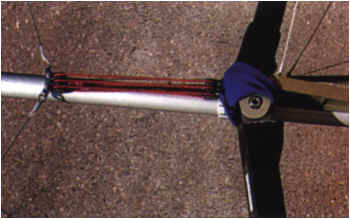
|
Figure 7:
A top view of the 7X VG pulley, system and the crossbar
center. Note the strong outrigger behind the crossbar
on the keel.
|
Weight should be mentioned as a slight negative on launch.
Those of us used to 7075-alloy kingpost gliders will note
an increase in weight with the Fusion. It is said to weigh
76 pounds. At a previous meet there were five different topless
gliders lined up in a row. I picked each of them up in succession
and found the Fusion, the Laminar ST and the Moyes CSX to
weigh exactly the same. So the Fusion's weight is not excessive
and is grouped with the lightest topless gliders except for
the TR3 which is all carbon graphite.
Landing the Fusion is straightforward and easy. I did it
in a crosswind, in gusts, in strong wind and in light wind,
as well as with the VG on in strong wind. My conclusion is
that the glider lands very easily without an overly-critical
flare window. Recreational pilots should not fear that the
Fusion will require any more than their usual landing skills
to keep them from providing landing field entertainment.
SETUP, BREAKDOWN, HARDWARE AND APPEARANCE
Setting up and breaking down a topless glider involves a
few different steps compared to a conventional glider. Of
course, there's no kingpost to erect or bridle lines to attach,
but there are those lovely sprogs to fasten.
On the Fusion you proceed with setup the same as with any
glider until you get the crossbar hauled back and fastened.
I found this haul back procedure sometimes difficult at first
with wind on my tail, because as with all topless gliders
the crossbar has an outrigger that rests on the keel to keep
the crossbar and wings from twisting when the crossbar is
partially folded. This outrigger can create a lot of friction
drag when wind pushes down on the wing. The solution: enlist
the aid of a buddy to lift a wing or turn the glider crosswise
to the wind.
|
Figure
8: The Fusion's rear haul back
tang and catch. Simple, neat, efficient.
|
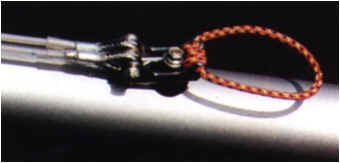
|
The holdback attachment in general is not difficult to put
on and take off It consists of a fitting with a keyhole that
slides over a bolt and into a slot on the bolt head. I sure
like the simplicity of this system which has been a Wills
standard since the RamAir (see photo).
Once the crossbar is fixed it's time to apply the sprogs.
To do this you open the V-shaped lower surface zippers, reach
in to grab the sprog, swing it out in position and attach
a short lanyard with a clip to the sprog end. The sprog is
thus held in the proper place to do its mighty stuff. Inspect
the internals and zip the hole closed to complete.
|
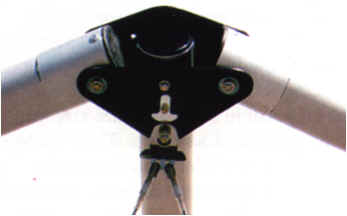
|
Figure 9:
The nose plate arrangement
on the Fusion shows the keyhole lower cable tang.
|
Fusion setup is again the usual: Put in the tip struts and
battens, attach the front cables and nose cone. The lower
front cables also employ a keyhole tang which I praise. The
control bar apex slides forward and back which allows the
correct geometry for laying the glider flat on the ground
by folding the control bar back.
One final point is to mention the hang strap standoff rocker
arm or yoke. This device is a short bar that is propped up
across the keel (see photo) which serves to reduce roll pressures
like a kingpost hang point. This yoke must be lifted off and
put back on its support during breakdown and setup so it doesn't
impinge upon the sail.
The breakdown of the Fusion is essentially the reverse of
the setup. A minor glitch occurs when trying to roll the sail,
since both the sprog and the washout strut are prevented from
folding nicely against the leading edge by the internal cloth
ribs. However, with a little bit of ingenuity and practice
you can achieve a reasonable semblance of a neat package and
be proud of your bundled glider.
|
Figure
10: This view of the Fusion's heart area shows the hang
point rocker arm, the sliding control
bar apex and the rear of the crossbar outrigger.
|
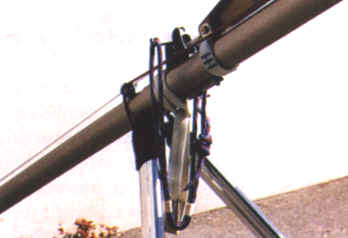
|
Before we leave this setup and break down business I should
mention that any extra hassle concerning the Fusion is similar
to all the topless gliders I have flown (four designs). However,
I must point out my second mild criticism of the Fusion. The
undersurface battens (three per side) are very difficult to
put in due to Velcro tabs which must be pulled out of the
way so the batten can be inserted. These tabs often get folded
over or stuck in the batten pocket, so inserting these battens
requires two hands fiddling and takes about twice as long
as it has to. A Wills spokesman said they may change this
arrangement.
The rest of the Fusion's hardware and layout is admirably
functional. Look at the photos and you will see custom-machined
parts and neat engineering everywhere. Note especially the
graphite crossbar shape. Its curved tips allow the lower surface
sail to under-camber a bit for good lift production. The unique
Wills Wing folding base tube comes stock on the Fusion. Also,
the downtubes are a new extrusion made exclusively for Wills
Wing with an extra boundary layer trip strip.
Perhaps one of the most important Fusion refinements is one
that will be little noticed. The Fusion's designer, Steve
Pearson, was the inventor of the crescent shaped inserts that
allow tubes to be stepped down to any size and thus free designers
of hang gliders to more readily follow their imagination.
With the Fusion, Steve took the concept one step further.
He placed a crescent insert at the end of the inboard leading
edge tube with a circular insert further in. The result is
that the outboard leading edge is no longer held parallel
to the inboard piece, but tilts forward and down. This partially
compensates for the usual bowing of the outboard leading edge
under flight loads.
Conclusion: The Fusion sets up and breaks down about on a
par with other topless designs. Takeoff and landing are easy
which makes it better than some designs.
ON FINAL
Wills Wing has been in the business a long time -- since
1973. They will certainly continue their success well into
the future if they keep turning out products like the Fusion.
This is almost an every-man's glider ('almost" because as
yet only one size exists and not every pilot wants cutting
edge performance). This is almost a perfect glider.
Before we give you the dry data and specs we should mention
a few bonuses that come with every Fusion. For the price of
admission you get custom colors which can be a split lower-surface
pattern or an asymmetric inlay WW with contrasting colors
at the tip. You also get tip inserts and winglets are optional.
The glider arrives with Wills Wing's traditional bulletproof
cover of 500 Cordura.
I suggest getting the special cross-country bag. It is the
best I've seen with a waterproof inside and an easy-to-hide
out side color. Each glider is also delivered with an admirably
complete and clear owner's manual as well as a spare parts
packet, and embroidered hat, a batten diagram, a response
form and guaranteed membership in the Wills Wing customer
support group. Don't forget the WW Web site which provides
owner's manuals, technical support and drawings so you can
figure out what part you may need or even what colors to order
for your new glider.
If moving up to a new topless glider is your destiny, be
sure to test-fly the one that is a synthesis of some of the
best ideas that fly -- the Fusion.
|